Alaska’s native plants survive temperatures that plummet to -60°F, making them nature’s ultimate survivors. You’ll discover these remarkable species have developed antifreeze proteins, compact growth forms, and specialized root systems that penetrate permafrost. Arctic Forget-Me-Nots bloom for just six weeks, while Fireweed colonizes disturbed soil within days of snow melt. Understanding which hardy natives thrive in your specific zone could transform your garden into a resilient landscape that mirrors Alaska’s wilderness.
Contents
- 1 Alaska’s Harsh Climate Challenges
- 2 Arctic Wildflowers That Thrive
- 3 Cold-Resistant Native Trees
- 4 Berry-Producing Arctic Shrubs
- 5 Selecting the Right Native Plants for Your Garden
- 6 Frequently Asked Questions
- 6.1 How Do I Propagate Native Alaskan Plants From Seeds or Cuttings?
- 6.2 What Specific Soil Amendments Work Best for Native Plants in Alaska?
- 6.3 When Is the Optimal Planting Time for Native Species in Alaska?
- 6.4 How Often Should I Water Newly Planted Native Alaskan Plants?
- 6.5 Which Native Plants Attract Pollinators During Alaska’s Short Growing Season?
Alaska’s Harsh Climate Challenges
While most of the United States deals with gradual climate shifts, Alaska faces dramatic environmental changes that challenge even its hardiest native plants. You’re looking at temperatures that’ve jumped 3°F statewide, with winter temps spiking 6°F higher than historical averages.
Your native plants must now survive growing seasons that’ve expanded 45% beyond the century average. These rapid changes demand robust climate adaptation strategies from Alaska’s flora. Increased evaporation from warming creates drier landscapes despite more precipitation, making soil conservation methods critical for plant survival in this transformed environment.
Arctic Wildflowers That Thrive
Alaska’s harsh climate produces remarkably resilient wildflowers, from vibrant Arctic Poppies and Lupines to early spring bloomers, native orchids, and additional hardy species that flourish in extreme conditions. With over 1500 species of wildflowers found throughout Alaska, these plants demonstrate incredible adaptation to survive freezing temperatures, short growing seasons, and challenging terrain.
Arctic Forget-Me-Not
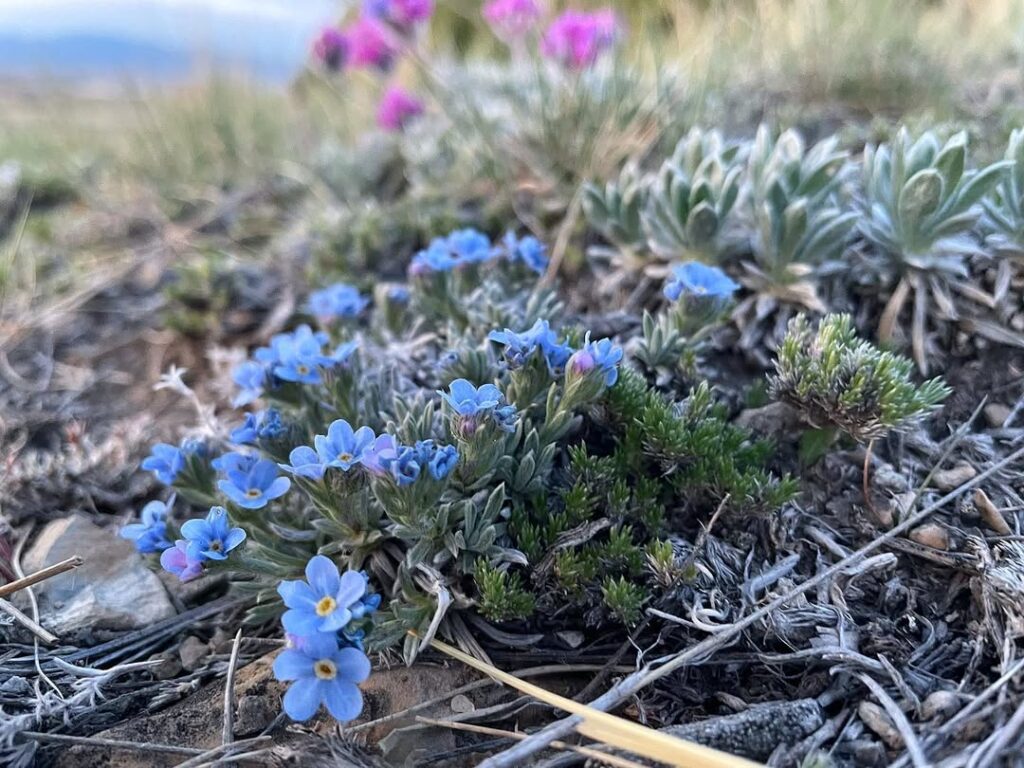
The Arctic forget-me-not (Myosotis asiatica) is Alaska’s official state flower and a remarkable alpine wildflower that thrives in the state’s harshest conditions. This low-growing perennial forms dense, cushion-like clumps that produce clusters of fragrant, deep blue flowers from June through August. Standing just 5-12 inches tall, it has adapted specialized mechanisms to survive extreme cold, including antifreeze proteins and dense, hairy foliage for insulation.
Found naturally in rocky terrain and tundra slopes above 5,000 feet, this resilient wildflower symbolizes endurance and remembrance while providing essential early-season nectar for arctic pollinators. Its robust root system helps stabilize fragile arctic soils, making it both ecologically important and culturally significant throughout Alaska. The flowers feature distinctive funnel-shaped blooms with five yellow pads positioned around the opening, creating an intricate pattern that guides pollinators to nectar sources.
- Hardiness: Extremely cold hardy, survives in permafrost conditions and frequent freeze-thaw cycles
- Light: Full sun to partial shade, adapted to extreme Arctic photoperiods
- Water: Moderate moisture requirements, prefers well-drained but consistently moist soils
- Soil: Thrives in rocky, gravelly, or sandy soils; tolerates nutrient-poor and alkaline conditions
- Fertilizer: No fertilization needed; adapted to low-nutrient alpine environments
- Pest/Disease Resistance: Highly resistant due to harsh growing conditions and specialized adaptations
- Growth Rate: Slow to moderate, forms spreading clumps over time
Alpine Arnica
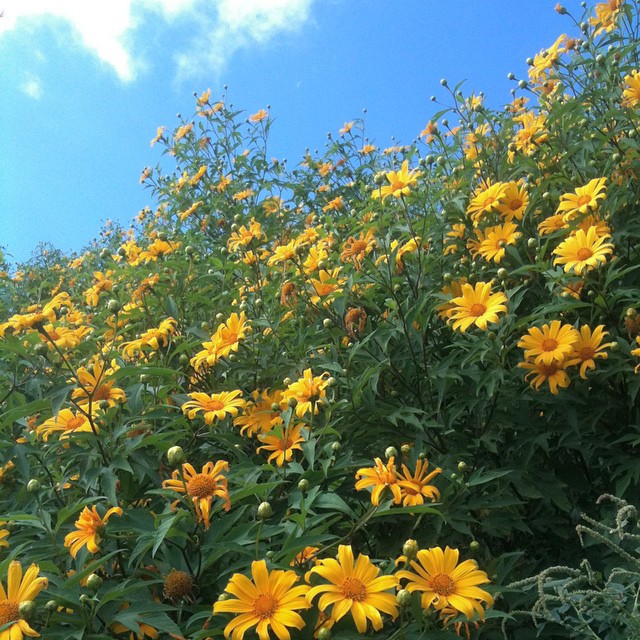
Alpine Arnica is a resilient perennial herb that produces stunning bright yellow, daisy-like flowers measuring 5-7 centimeters across. Growing 16-24 inches tall with lance-shaped, toothed leaves arranged in opposite pairs, this hardy wildflower thrives in Alaska’s harsh alpine environments at elevations between 5,000-10,000 feet.
This remarkable plant has evolved specialized survival mechanisms including antifreeze proteins and an extensive rhizome system that spreads horizontally just below the soil surface. Its flower heads turn to track sunlight like solar collectors, while feathery seed bristles enable wind dispersal across rocky alpine terrain. With an estimated 12-year lifespan, Alpine Arnica serves as an important native alternative to invasive species while contributing to alpine biodiversity. The plant reaches heights of up to 16 inches in the most extreme alpine conditions.
- Hardiness: Extremely cold hardy, withstands freezing temperatures with antifreeze proteins
- Light: Full sun to partial shade, flower heads track strongest light
- Water: Moderate moisture, tolerates moderately dry conditions once established
- Soil: Adapts to various soil types, prefers exposed mineral soils, rocky slopes
- Fertilizer: Low fertility requirements, forms mycorrhizal partnerships for nutrient absorption
- Pest/Disease Resistance: High resistance due to harsh alpine adaptation
- Growth Rate: Moderate, spreads through rhizomes and self-seeding
Fireweed
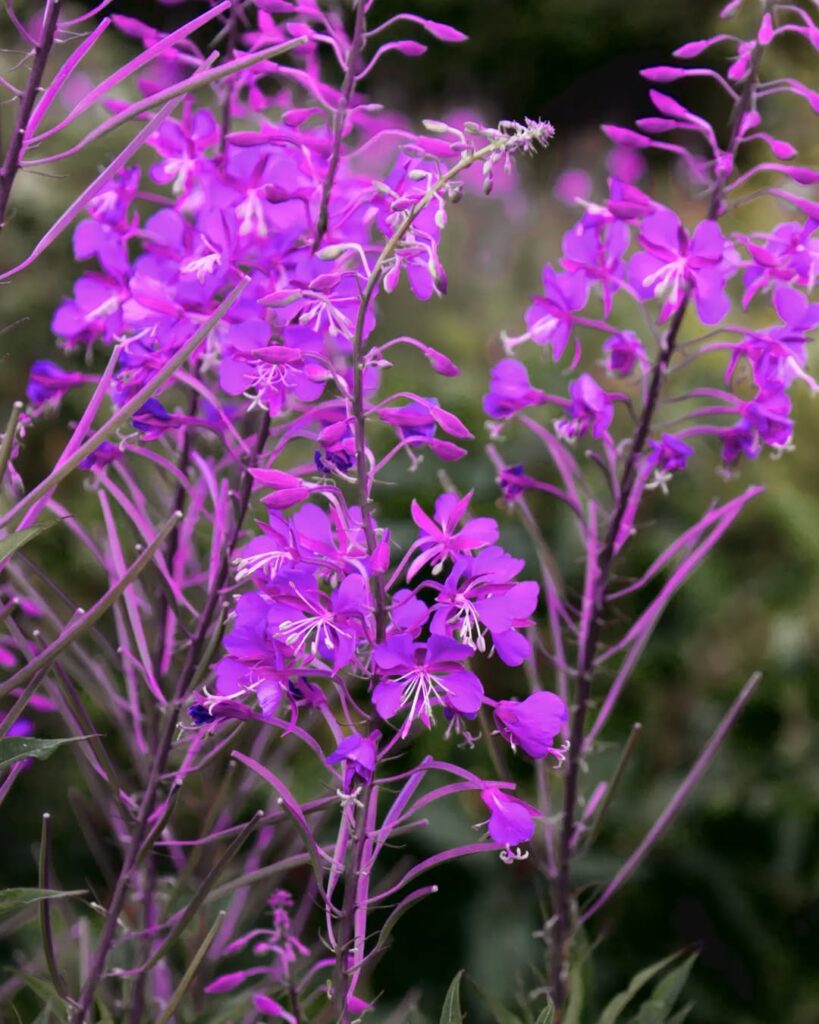
Fireweed is Alaska’s most iconic wildflower, renowned for its brilliant pink-magenta blooms that tower up to 5 feet tall. This resilient perennial thrives in disturbed landscapes, particularly after wildfires where it rapidly colonizes burned areas and prevents soil erosion. With its distinctive tall reddish stems, elongated leaves, and spike-like flower clusters, fireweed creates spectacular displays from late June through September.
Beyond its striking beauty, fireweed serves as a vital indicator species for early forest succession and provides essential nectar for pollinators during Alaska’s brief growing season. The plant is an important honeybee plant in Canada and Alaska, contributing significantly to local honey production. The plant’s remarkable reproductive capacity—producing up to 80,000 wind-dispersed seeds annually—enables it to quickly establish dense stands across vast areas, making it a symbol of nature’s resilience and recovery.
- Hardiness: Extremely hardy perennial, native to Alaska’s boreal and temperate regions
- Light: Full sun to partial shade, thrives in sun-exposed areas
- Water: Adaptable to both dry and moist conditions, including wet places and upland meadows
- Soil: Prefers disturbed soils, tolerates poor conditions, excellent for erosion control
- Fertilizer: No fertilizer needed, thrives in nutrient-poor soils
- Pest/Disease Resistance: Highly resistant, very few pest or disease issues
- Growth Rate: Rapid establishment from seeds and rhizomes, quick post-disturbance colonization
Wild Lupine
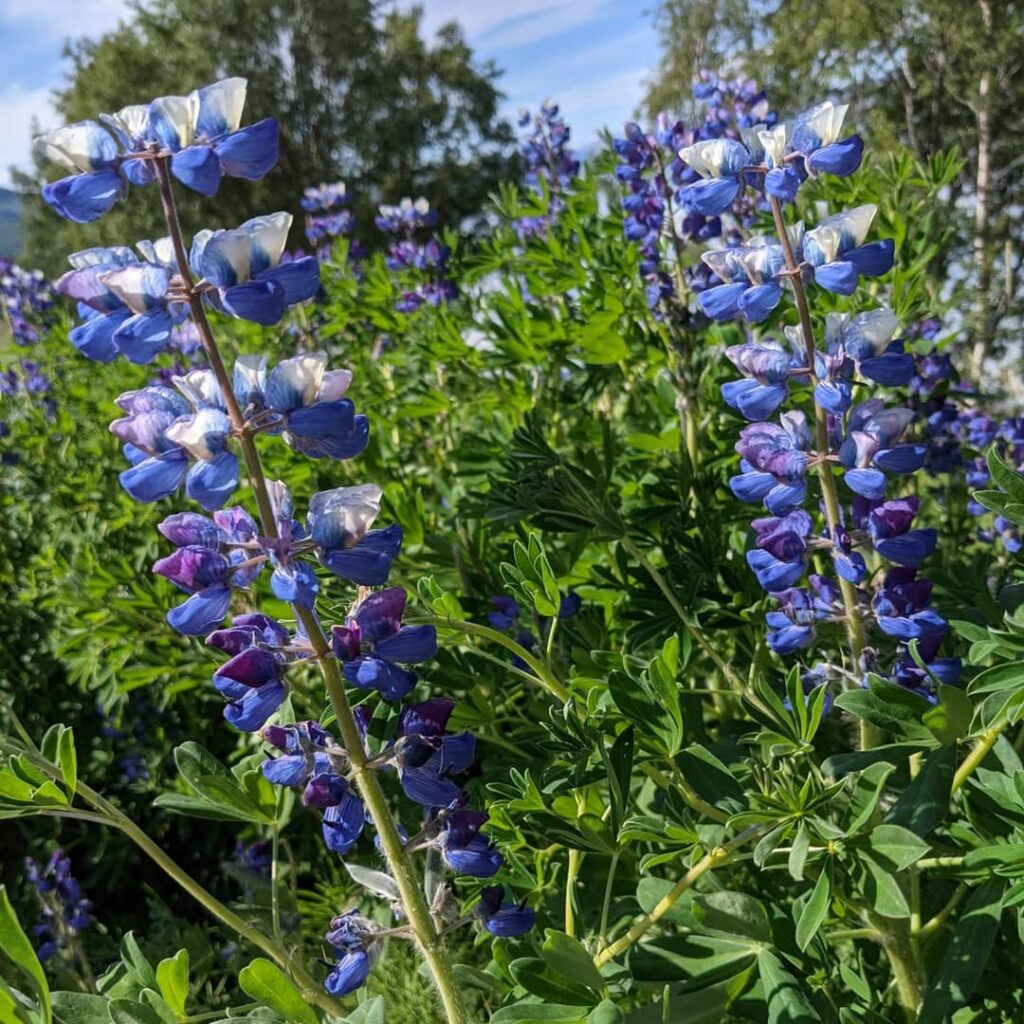
Wild lupine stands as one of Alaska’s most resilient arctic wildflowers, displaying striking blue to purple pea-like blooms on tall spikes from late spring through summer. This hardy perennial thrives in Alaska’s challenging conditions, reaching heights up to 5 feet with distinctive palmately compound leaves featuring 7-17 leaflets. Beyond its ornamental value, wild lupine serves essential ecological functions by fixing nitrogen in poor soils and providing vital habitat for pollinators and wildlife, including serving as a larval host for specialized butterfly species. The plant’s seeds and foliage require careful handling, as they contain toxic alkaloids that can cause serious health issues if consumed in large quantities by humans or animals.
- Hardiness: Extremely cold-tolerant, surviving temperatures down to -25°F, suitable for USDA zones 3-8
- Light: Full sun to partial shade, prefers sunny locations for ideal flowering
- Water: Drought-tolerant once established, requires well-drained conditions to prevent root rot
- Soil: Thrives in sandy, dry to moist soils with average to low fertility; avoid heavy, waterlogged, or overly rich soils
- Fertilizer: Low fertilizer needs due to nitrogen-fixing capability; excessive nutrients can cause problems
- Pest/Disease Resistance: Naturally deer-resistant, susceptible to crown rot in poorly drained soils
- Growth Rate: Moderate growth rate with upright, spreading habit requiring 15-18 inch spacing
Arctic Poppies
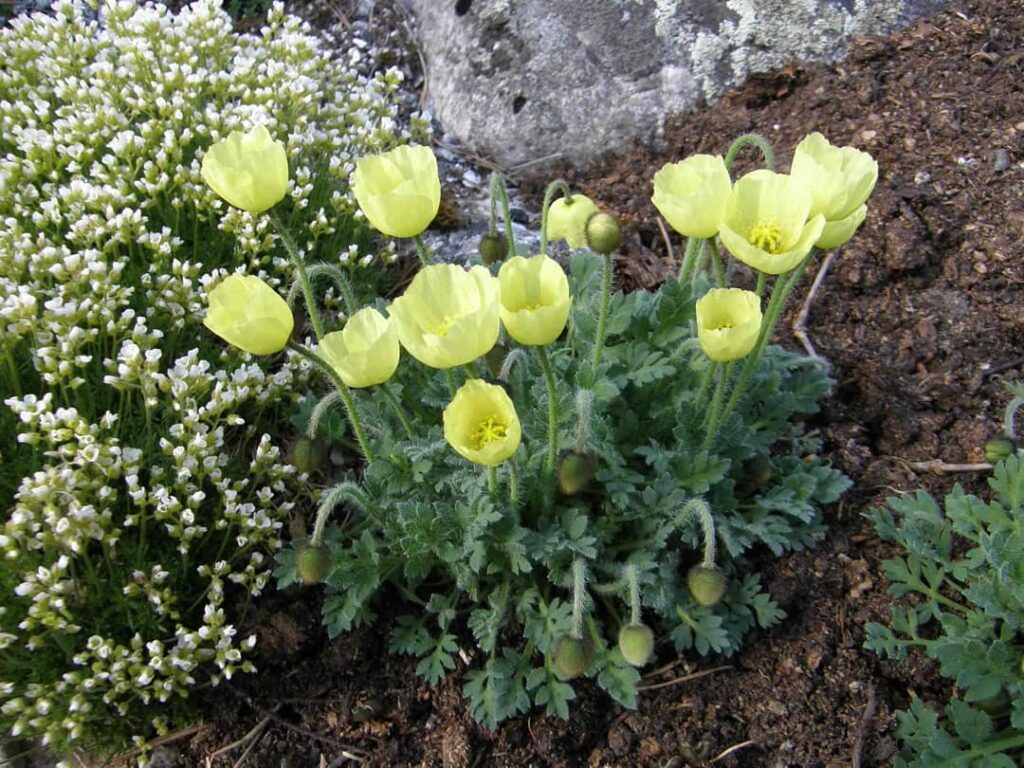
Arctic poppies are remarkable wildflowers that showcase nature’s ability to create beauty in the harshest environments. These delicate cup-shaped blooms in vibrant yellow, white, or orange hues stand 5-15 inches tall across Alaska’s tundra landscape. Despite their fragile appearance, arctic poppies demonstrate extraordinary resilience, surviving temperatures as low as -40°C through specialized adaptations including antifreeze proteins and protective bristly hairs.
These hardy natives serve as crucial indicators of Arctic ecosystem health while providing essential color during Alaska’s brief summer growing season. Their heliotropic behavior allows them to track the sun’s movement, maximizing light absorption when daylight hours are precious. Arctic poppies achieve 60% higher photosynthetic rates compared to similar species at lower latitudes due to their specialized adaptations to continuous summer daylight. With their extensive taproot systems penetrating up to 24 inches deep, arctic poppies anchor securely in rocky soils while contributing to biodiversity in one of Earth’s most challenging biomes.
- Hardiness: Extremely cold tolerant, surviving temperatures to -40°C in USDA zones 2-6
- Light: Full sun exposure with heliotropic sun-tracking behavior
- Water: Low to moderate water needs; drought tolerant once established
- Soil: Well-drained rocky or gravelly soils; alkaline to neutral pH preferred
- Fertilizer: Minimal fertilizer requirements; adapted to nutrient-poor arctic soils
- Pest/Disease Resistance: Excellent natural resistance due to harsh growing environment
- Growth Rate: Slow to moderate; compact growth pattern with short growing season
Cold-Resistant Native Trees
Alaska’s cold-resistant native trees have evolved remarkable adaptations to survive extreme winters, with spruce, birch, willow, and poplar species forming the backbone of northern forests. The Dahurian Larch stands out as the most cold-hardy tree in the world, featuring a stunning conical crown and soft green needles that turn golden in fall.
Paper Birch
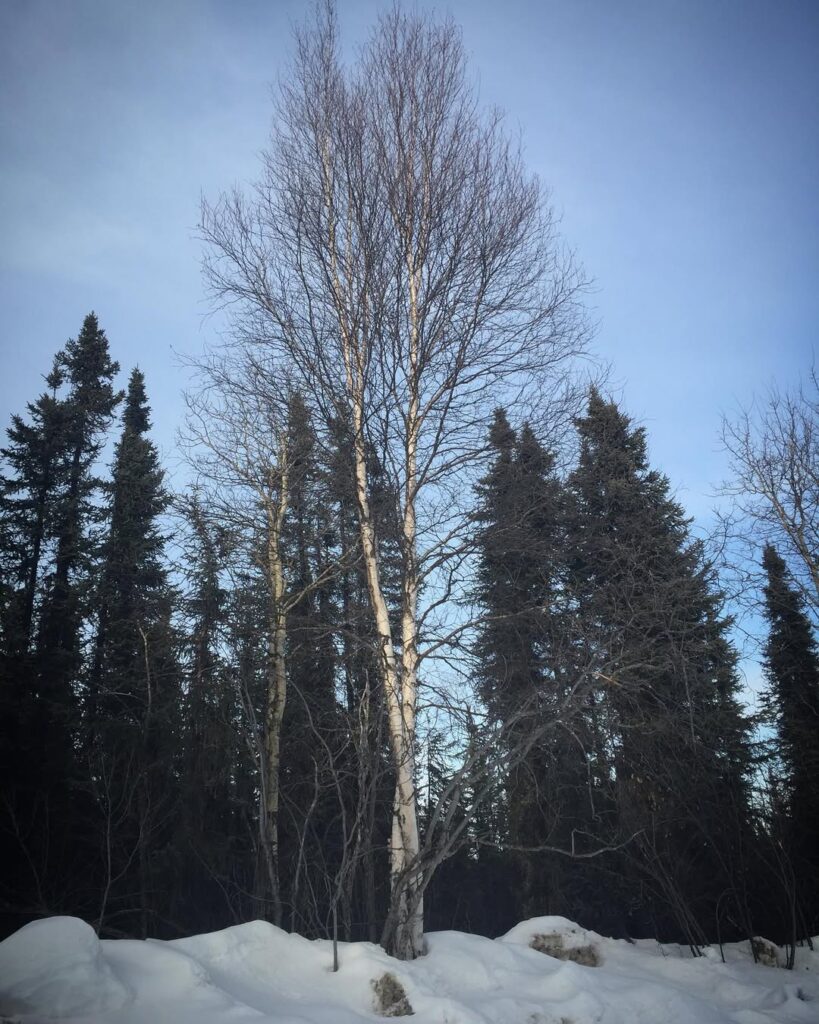
Paper birch stands as one of Alaska’s most recognizable and resilient native trees, thriving in some of the harshest conditions on Earth. With its distinctive white bark that peels in papery sheets and exceptional cold tolerance to temperatures below -50°C, this hardy species has adapted perfectly to Alaska’s extreme subarctic climate. Growing 15-20 meters tall with shallow root systems that quickly access nutrients from briefly thawed surface soils, paper birch serves as a vital pioneer species in forest regeneration.
Beyond its ecological importance, paper birch provides significant economic and cultural value. Indigenous peoples have long utilized its waterproof bark for canoes, baskets, and shelters, while the light-colored wood serves modern uses in plywood and pulp production. The tree’s ability to rapidly colonize disturbed areas makes it essential for post-fire recovery, while its browse value supports wildlife populations including moose and snowshoe hare. Paper birch contributes significantly to carbon sequestration processes in Alaska’s boreal ecosystems.
- Hardiness: USDA Zones 0a-2b, withstands temperatures below -50°C (-58°F)
- Light: Full sun to partial shade
- Water: Moderate moisture, tolerates seasonal flooding and drought
- Soil: Well-draining mineral soils, shallow permafrost soils, requires exposed mineral soil for germination
- Fertilizer: Low requirements, adapted to nutrient-poor boreal soils
- Pest/Disease Resistance: Generally hardy, susceptible to browsing damage from moose and hare
- Growth Rate: Fast-growing pioneer species, ceases height growth at 60-70 years
Quaking Aspen
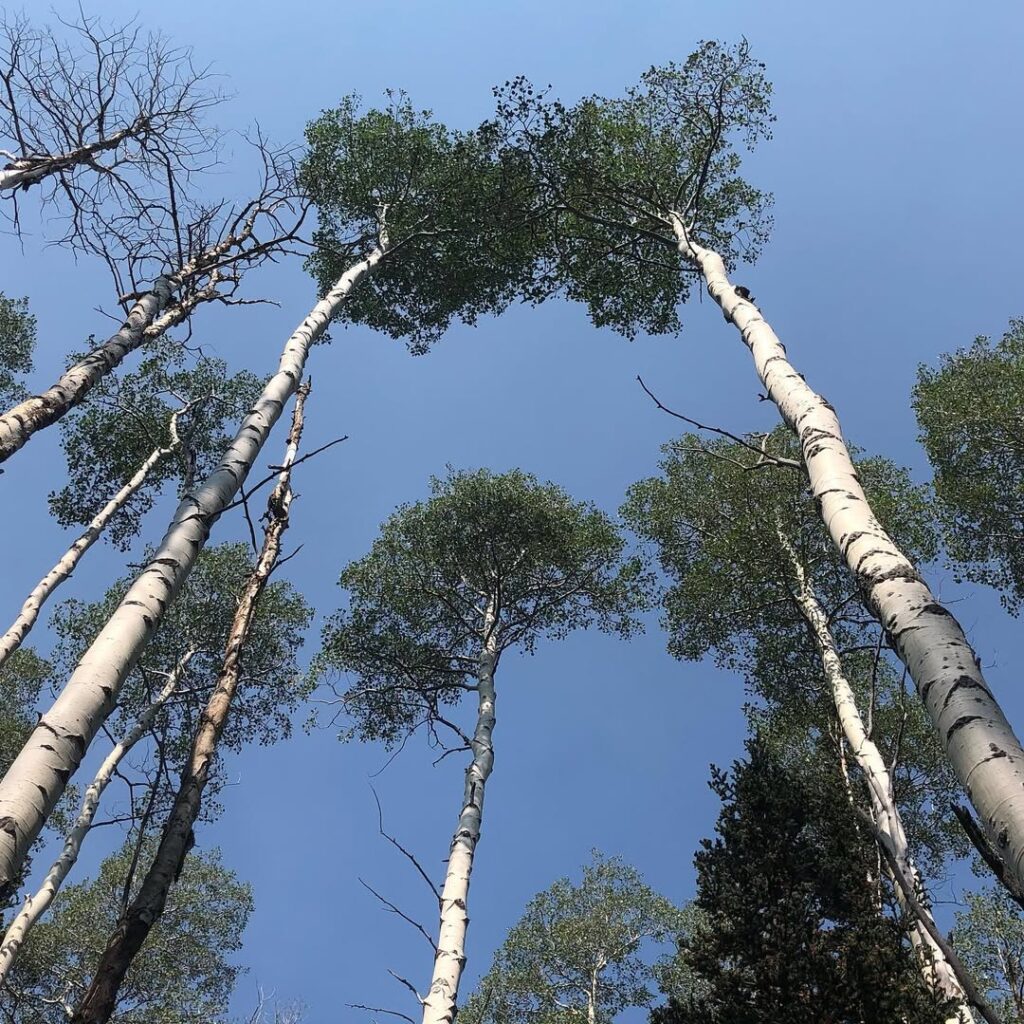
Quaking aspen is one of Alaska’s most remarkable native trees, capable of surviving extreme cold conditions while creating stunning natural landscapes. This deciduous tree gets its name from leaves that tremble in the slightest breeze due to their flattened petioles. Growing 15-18 meters tall with distinctive smooth, whitish bark, quaking aspen forms large clonal groves through an extensive root system that can persist for thousands of years.
What makes this species particularly suited for Alaska’s harsh climate is its unique bark that performs photosynthesis during winter months when the tree is leafless. The fast-growing tree tolerates long winters and deep snow, making it an excellent choice for northern landscapes. In fall, the small round leaves turn brilliant golden yellow, creating dramatic autumn displays across Alaska’s wilderness. These trees provide essential habitat and food for wildlife including deer, moose, elk, and ruffed grouse throughout Alaska’s wilderness areas.
- Hardiness: Extremely cold hardy, survives Alaska’s harsh winters and extreme cold conditions
- Light: Full sun to partial shade
- Water: Moderate moisture requirements, tolerates seasonal variations
- Soil: Adaptable to various soil types, prefers well-drained conditions
- Fertilizer: Low maintenance, typically does not require supplemental fertilizing
- Pest/Disease Resistance: Susceptible to diseases and insect infestations due to thin, soft bark
- Growth Rate: Fast-growing, especially in favorable conditions
White Spruce
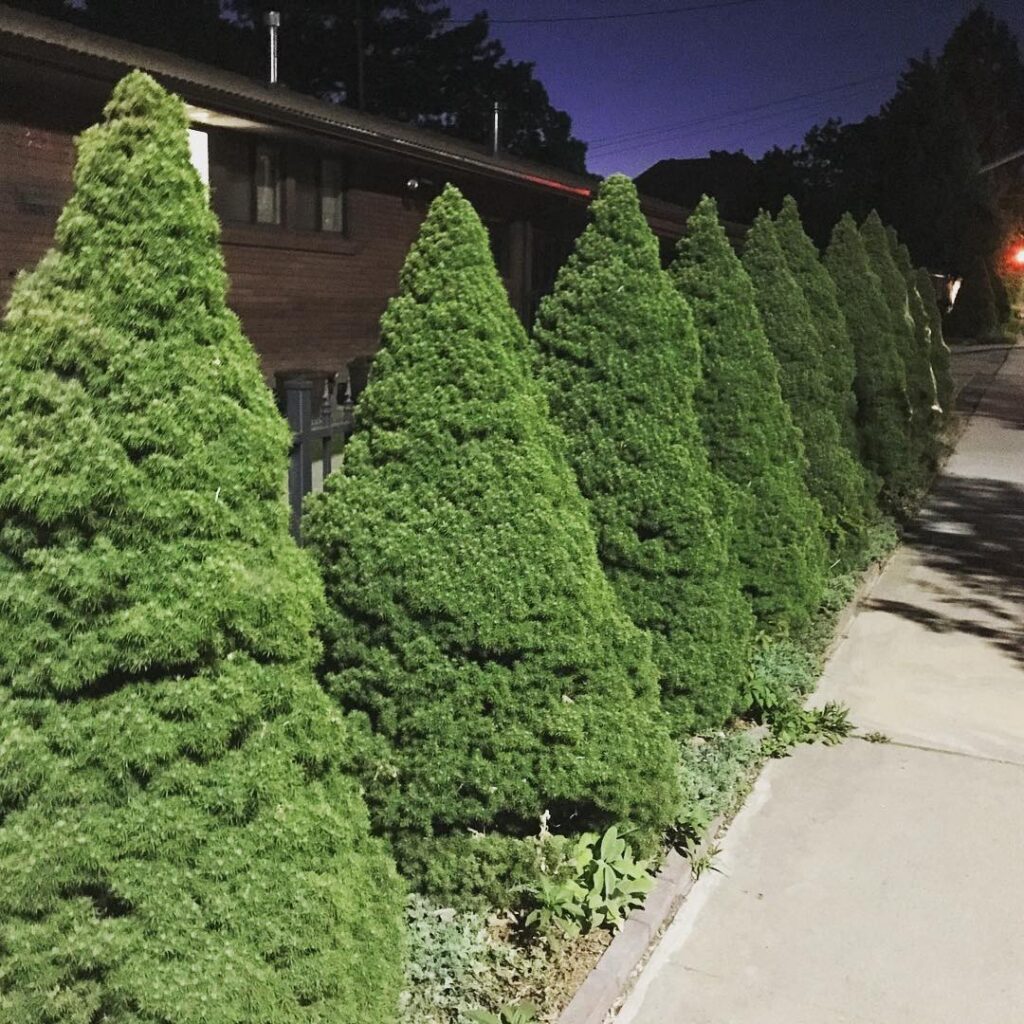
White spruce is Alaska’s dominant boreal forest tree, reaching 40-70 feet tall with a characteristic narrow, spire-like crown and drooping branches. This cold-hardy native conifer features short blue-green needles and thin, scaly bark that flakes off in circular plates. As a climax species in Alaska’s taiga, white spruce forms pure stands or grows alongside black spruce, birch, and aspen.
The species thrives in Alaska’s harsh climate, from riparian areas to treeline elevations. Its resinous needles and dense branching pattern create full crowns that extend nearly to ground level. White spruce produces small winged seeds and develops into one of Alaska’s most versatile timber species, valued for its fine-textured, easily worked wood. These exceptionally long-lived trees can survive for several hundred years, with some specimens in rigorous climates exceeding 300 years of age.
- Hardiness: Extremely cold-hardy, thrives in Alaska’s boreal climate zones
- Light: Full sun to partial shade, tolerates low light in dense forest stands
- Water: Moderate water needs, drought tolerant once established
- Soil: Well-drained soils preferred, performs poorly on waterlogged sites
- Fertilizer: Low nutrient requirements, adapted to poor boreal soils
- Pest/Disease Resistance: Good resistance to most pests and diseases in native range
- Growth Rate: Slow to moderate growth rate in Alaska’s climate
Black Spruce
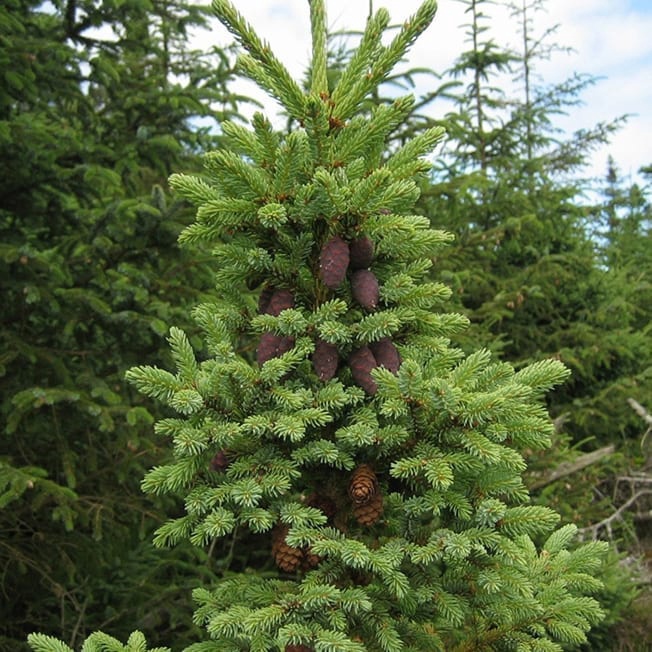
Black spruce is an exceptionally hardy evergreen tree native to Alaska’s harsh northern climate. This small, narrow conifer rarely exceeds 45 feet in height and features distinctive dark bluish-green needles that create a blackish foliage appearance. Its spire-like crown and descending branches that often sweep the ground make it well-adapted to extreme cold conditions.
As a climax species in Alaska’s northern forests, black spruce thrives in areas where other trees cannot survive. It shows remarkable tolerance for cold, wet soils and permafrost conditions, making it an essential component of boreal forest ecosystems. The tree’s extremely slow growth rate and ability to layer branches for new growth help it persist in challenging environments. Black spruce produces the smallest cones among all spruce species, measuring only 1.5-4cm long and perfectly adapted to harsh northern conditions.
- Hardiness: Zones 2-6, extremely cold tolerant, thrives in permafrost areas
- Light: Full sun (6+ hours direct sunlight daily)
- Water: Tolerates wet sites and occasional drought; prefers moist conditions
- Soil: Acid soil preferred; adapts to poorly drained, wet, or well-drained soils
- Fertilizer: Low requirements; adapted to nutrient-poor boreal soils
- Pest/Disease Resistance: Generally resistant due to harsh growing conditions
- Growth Rate: Extremely slow compared to other conifers
Tamarack Larch
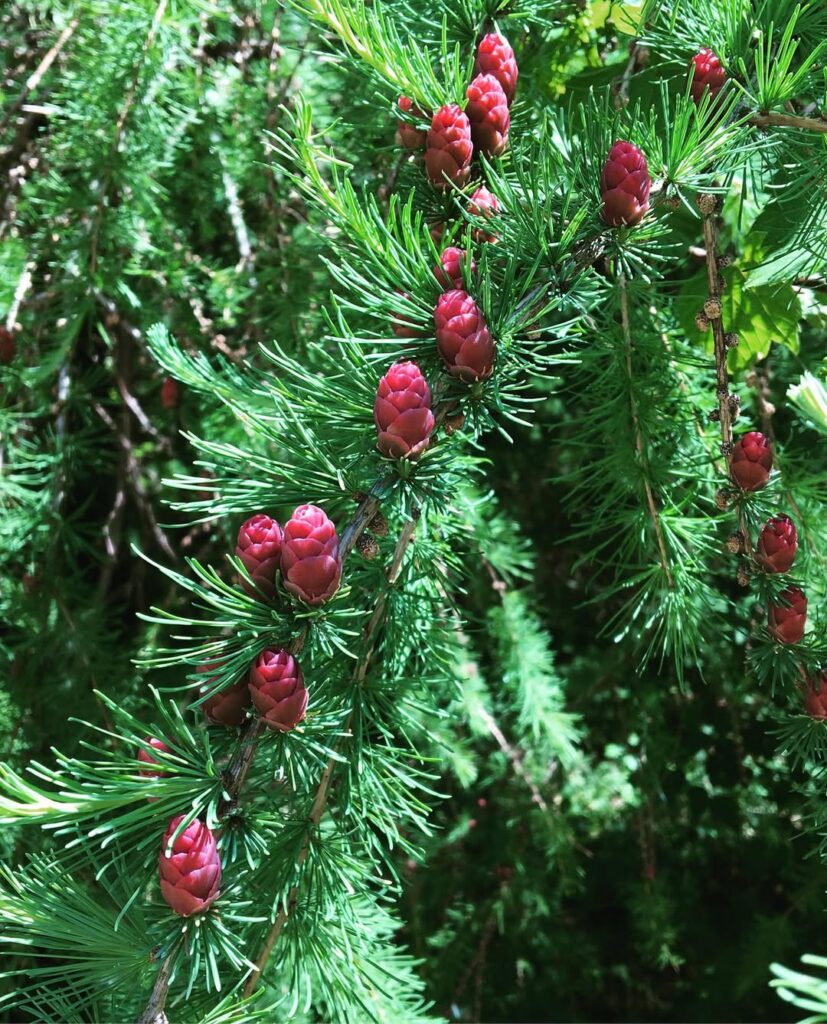
The Tamarack Larch is an exceptionally hardy deciduous conifer native to Alaska’s wetlands and bogs. This remarkable tree thrives in some of the harshest conditions, including permafrost soils and waterlogged peatlands where few other trees can survive. Growing 50-75 feet tall with a distinctive conical form, it features bright green needles that turn golden yellow in fall before dropping.
What makes Tamarack Larch particularly valuable is its unique adaptations to extreme cold and wet conditions. Its shallow root system allows it to flourish in oxygen-poor, saturated soils, while its deciduous nature prevents winter damage from ice and reduces water loss. The tree produces small cones and serves as essential habitat for wildlife while contributing to carbon storage in northern ecosystems. Young stems are traditionally used in Alaska for sled runners and fish traps due to their durability and flexibility.
- Hardiness: Extremely cold-hardy, tolerates permafrost and extreme temperature fluctuations
- Light: Full sun to partial shade
- Water: High moisture requirements; thrives in waterlogged, flooded conditions
- Soil: Prefers acidic, organic-rich peat soils; tolerates saturated, oxygen-poor conditions
- Fertilizer: Minimal requirements; adapted to nutrient-poor bog conditions
- Pest/Disease Resistance: Generally resistant due to harsh growing conditions that limit pests
- Growth Rate: Slow to moderate in harsh bog conditions
Berry-Producing Arctic Shrubs
Alaska’s Arctic regions host resilient berry-producing shrubs that have adapted to extreme cold, short growing seasons, and nutrient-poor soils while providing essential food sources. These hardy plants, including prickly rose, highbush cranberry, lingonberry, and crowberry, serve as critical food sources for Arctic and boreal animals during the harsh fall and winter months when other nutrition becomes scarce.
Cloudberry (Rubus Chamaemorus)

Cloudberry (Rubus chamaemorus) is a low-growing herbaceous perennial native to Alaska’s Arctic and subarctic regions. This hardy member of the rose family produces distinctive amber-colored berries rich in vitamin C and other nutrients. Reaching only 10-25 cm in height, cloudberry features handlike lobed leaves and spreads through creeping rhizomes.
As a dioecious plant, cloudberry requires both male and female plants for successful fruit production. The raspberry-sized aggregate berries ripen in late summer and serve as an important food source for wildlife and humans in harsh northern climates. The Yupik people in Alaska consider cloudberries an important traditional food resource.
- Hardiness: Extremely cold hardy, thrives in Arctic and subarctic climates
- Light: Shade tolerant, performs well in partial shade to full sun
- Water: Prefers consistently moist to wet conditions, tolerates dry sites
- Soil: Acidic soils preferred, thrives in wetland conditions and raised bogs
- Fertilizer: Low requirements, adapted to nutrient-poor northern soils
- Pest/Disease Resistance: Generally resistant due to harsh native environment
- Growth Rate: Slow to moderate, spreads gradually through rhizomes
Lingonberry (Vaccinium Vitis-Idaea)
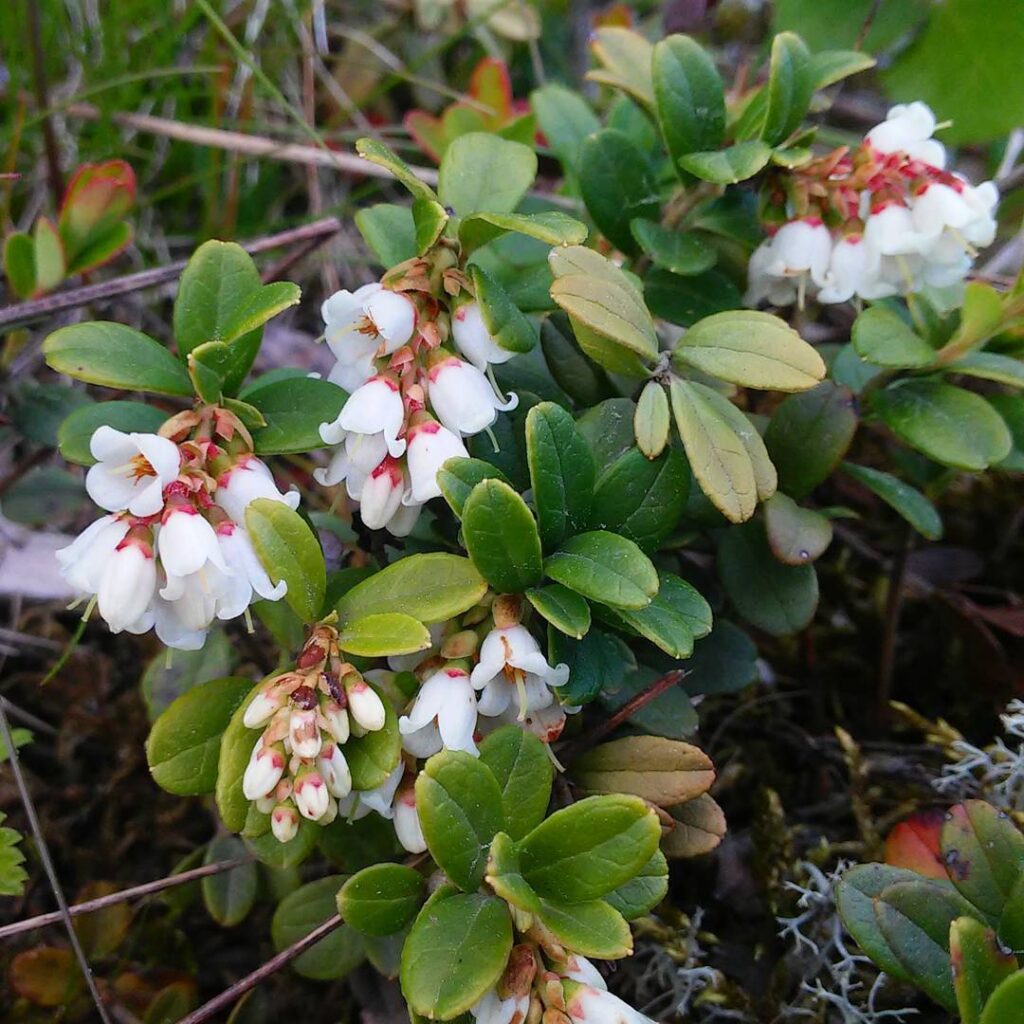
Lingonberry (Vaccinium vitis-idaea) is an exceptionally hardy, low-growing evergreen shrub native to Alaska’s boreal forests and Arctic tundra. This mat-forming plant reaches about 6 inches tall and produces delicious red berries that taste like a cross between cranberries and blueberries. Also known as partridgeberry or mountain cranberry, it retains its leathery oval leaves throughout winter and provides critical food for wildlife including bears, moose, and caribou.
The plant blooms with pinkish bell-shaped flowers in June and July, followed by berries that often overwinter on the plant and become sweeter after snow melts. Lingonberries are commercially cultivated and contain more antioxidants than regular cranberries, making excellent jam and offering superior health benefits. Alaska natives have traditionally mixed lingonberries with rose hip pulp and sugar to create flavorful jams.
- Hardiness: Extremely cold hardy, tolerating temperatures to -50°F (-45°C) or lower
- Light: Partial shade preferred; benefits from forest canopy protection
- Water: Constantly moist conditions required
- Soil: Acidic, peaty soils; tolerates nutrient-poor conditions but not alkaline soils
- Fertilizer: Minimal requirements; adapted to nutrient-poor environments
- Pest/Disease Resistance: Generally resistant in native habitat conditions
- Growth Rate: Slow-growing, mat-forming habit
Crowberry (Empetrum Nigrum)
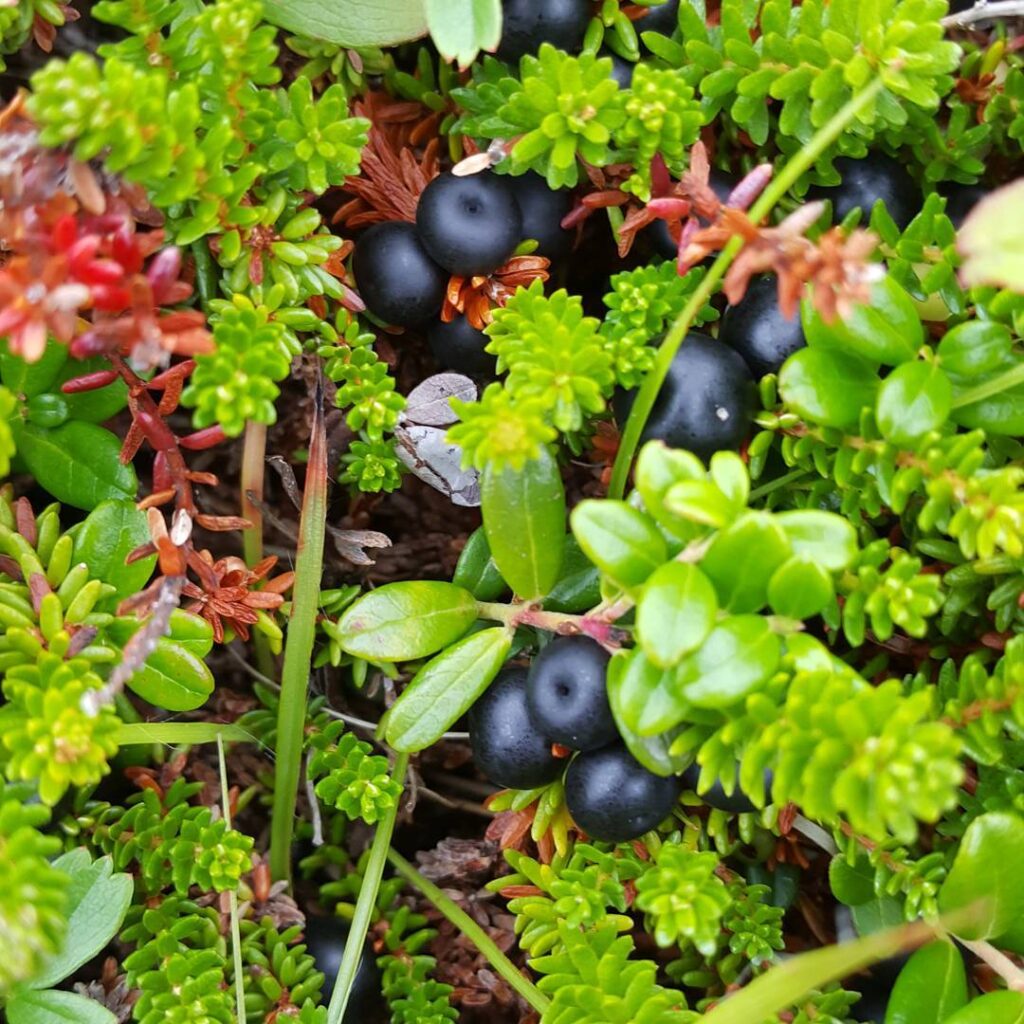
Crowberry (Empetrum nigrum) is a low-growing evergreen shrub in the heather family that forms dense carpet-like groundcover 6-12 inches tall. This hardy Arctic native produces needle-like dark green foliage and shiny dark blue-black berries that are sweet and juicy. Found throughout Alaska’s forests, muskegs, and tundra regions, crowberry extends across northern Canada to Labrador and Greenland.
The plant’s extensive root system penetrates up to 30 cm deep, enabling survival in extreme conditions with specialized cellular adaptations for temperatures below -40°C. Indigenous populations traditionally used various parts medicinally, while the berries provide essential winter wildlife food. The species exhibits allelopathic properties that can affect seed germination and root development of nearby plants, influencing local plant community composition. Crowberry can be propagated from cuttings and serves as excellent ground cover for Interior Alaska landscapes.
- Hardiness: Extremely cold tolerant, surviving temperatures below -40°C in Arctic and subarctic zones
- Light: Tolerates full sun to partial shade in northern climates
- Water: Moderate moisture needs, adapted to natural precipitation patterns
- Soil: Thrives in acidic, well-draining soils including sandy and rocky substrates
- Fertilizer: No fertilizer required, adapted to low-nutrient Arctic soils
- Pest/Disease Resistance: Highly resistant due to harsh native environment adaptations
- Growth Rate: Slow to moderate, forming dense mounded growth over time
Blueberry (Vaccinium Uliginosum)
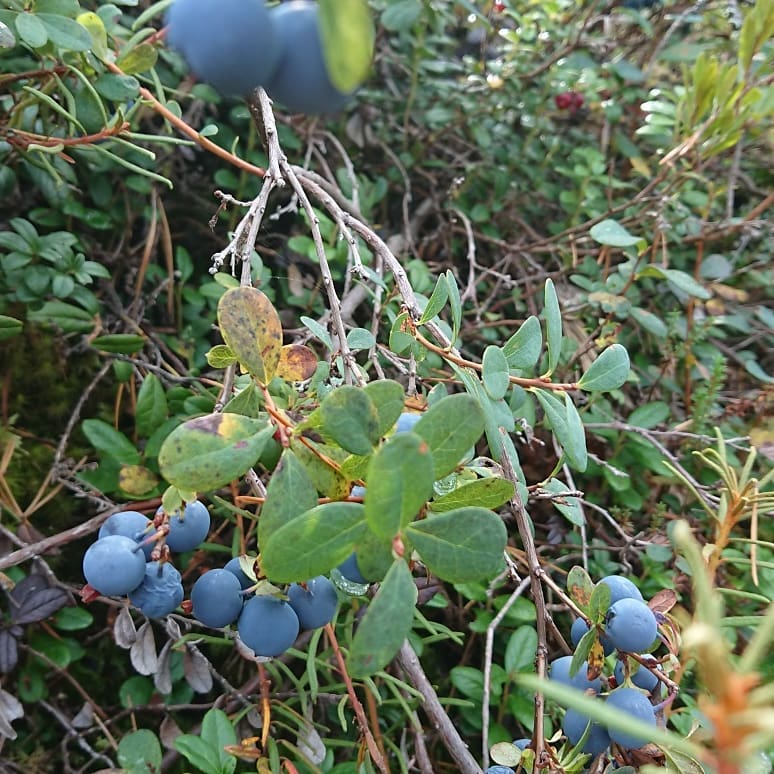
Blueberry (Vaccinium uliginosum), also known as bog bilberry or alpine blueberry, is a remarkably hardy deciduous shrub that thrives across Alaska’s diverse landscapes. Growing 4-25 inches tall, this cold-tolerant native produces distinctive urn-shaped white to pink flowers followed by blue-black berries with a characteristic bluish bloom. The plant features oval dark green leaves and develops extensive underground networks that help it survive harsh Arctic conditions.
This species demonstrates exceptional adaptability to extreme environments through specialized antifreeze compounds in its tissues and mycorrhizal partnerships that enhance nutrient uptake in poor soils. The berries ripen from late July through September, providing vital late-season forage for wildlife and serving as an important traditional food source for Indigenous communities throughout its circumpolar range. The shrub’s much branched growth habit allows it to form dense colonies that can withstand extreme weather conditions.
- Hardiness: Extremely cold-tolerant, survives Arctic temperatures with antifreeze compounds in tissues
- Light: Full sun to partial shade, adaptable to various light conditions
- Water: Prefers consistently moist to wet conditions, thrives in bogs and swamps
- Soil: Acidic, organic-rich soils; tolerates poor, sandy, or rocky conditions
- Fertilizer: Low nutrient requirements, relies on mycorrhizal partnerships for nutrient uptake
- Pest/Disease Resistance: Highly resistant due to harsh native environment adaptations
- Growth Rate: Slow to moderate, forms colonies through underground spreading
Salmonberry (Rubus Spectabilis)

Salmonberry (Rubus spectabilis) is a deciduous shrub native to Alaska’s coastal regions, reaching 1-4 meters in height with distinctive trifoliate leaves and magenta star-shaped flowers. This hardy plant produces edible yellow-orange to red berries resembling large raspberries, which have been a traditional food source for Indigenous peoples. The berries are high in vitamins C and K, along with manganese, making them nutritionally valuable for both wildlife and human consumption. The shrub spreads aggressively through underground stems, forming dense thickets that provide excellent wildlife habitat and erosion control.
Its robust nature and ecological benefits make salmonberry valuable for restoration projects and native landscaping. The plant supports pollinators, particularly rufous hummingbirds, while its dense growth provides cover for birds and small mammals throughout Alaska’s challenging growing seasons.
- Hardiness: Zones 3-8, tolerates temperatures from sea level to 1800 meters elevation
- Light: Partial shade to occasional full sun
- Water: Prefers moist to wet soils, adaptable to varying moisture levels
- Soil: Thrives in well-draining, organic-rich soils along streams and wetlands
- Fertilizer: Low maintenance, benefits from organic matter in natural settings
- Pest/Disease Resistance: Generally hardy with good natural resistance
- Growth Rate: Aggressive spreader, rapidly colonizes areas through underground stems
Selecting the Right Native Plants for Your Garden
When you’re ready to transform your Alaskan landscape with native plants, success depends entirely on matching each species to your garden’s specific conditions. Effective native plant selection starts with evaluating your site’s sunlight exposure, soil moisture, and drainage patterns.
Consider your region’s requirements carefully. Southcoastal areas suit Sitka Spruce, while Central Alaska favors acid-tolerant Tamarack. Match shade tolerance levels precisely—place Bearberry in sunny spots, Nagoonberry in partial shade, and Western Hemlock in heavily shaded areas.
These gardening techniques reduce maintenance needs considerably. Assess soil pH and organic content before planting, avoiding lime near acid-loving species for ideal growth. Native plants have developed unique adaptations that allow them to thrive despite Alaska’s harsh environmental challenges.
Frequently Asked Questions
How Do I Propagate Native Alaskan Plants From Seeds or Cuttings?
Like winter’s patient embrace awakening spring growth, you’ll need seed stratification for germination and specific cutting techniques. Take 4-8″ hardwood cuttings, apply rooting hormone, maintain 70°F bottom heat while keeping tops cool.
What Specific Soil Amendments Work Best for Native Plants in Alaska?
You’ll want Alaskan peat, fish meal, and seaweed for ideal nutrient balance. Test your soil pH first, then add lime if needed. Include sand or pumice for drainage, and apply low-nitrogen, high-phosphorus fertilizers regularly.
When Is the Optimal Planting Time for Native Species in Alaska?
You’ll want to follow a strategic planting calendar with key seasonal considerations: start spring sowing in early April when soils become workable, or sow just before winter freeze for cold-stratification species.
How Often Should I Water Newly Planted Native Alaskan Plants?
Ironically, Alaska’s “hardy” natives need babying—you’ll water twice weekly during their first month, then monitor soil moisture retention carefully. Deep, infrequent watering frequency works best until they’re established after two summers.
Which Native Plants Attract Pollinators During Alaska’s Short Growing Season?
You’ll want American pasqueflower for early spring, fireweed for mid-summer, and tall bluebells throughout Alaska’s growing season. These natives match pollinator preferences perfectly, with sequential blooming seasons supporting bees and butterflies continuously.
